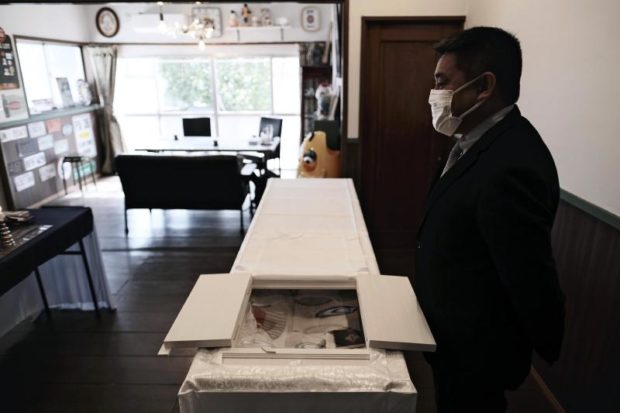
A small window in a coffin is opened so that people can see the face of the deceased before the body is cremated, in Tachikawa, Tokyo, in early March. The Yomiuri Shimbun
TOKYO — The Japanese government is finding ways to allow people whose loved ones have died of COVID-19 to bid a final farewell in person.
When the pandemic began, bereaved family members were not allowed to see the bodies in-person, and they were handed the remains only after cremation, in most cases.
Directly seeing the faces of deceased loved ones in the final moments of life can help ease the sense of loss. Thus, the Health, Labor and Welfare Ministry is studying the risk of infection from deceased people’s bodies.
Final farewell
Hiroko Asai, 76, of Adachi Ward, Tokyo, peered into the small window of a coffin at a facility of Todaisha, a funeral service company, in a residential area in Tachikawa, Tokyo.
The body inside the transparent body bag in the coffin was her husband, Masao. She leaned toward her husband’s body and said, “Thank you for such wonderful memories.”
Masao had diabetes and other chronic diseases. Three days before, he died at 79 in a hospital where he was undergoing rehabilitation.
He had become infected with the coronavirus during his hospitalization, which began in early January.
During that period, Hiroko had been unable to meet her husband in person and was also unable to be by his bedside when he died.
“I didn’t want to just have his bones handed over after cremation,” Hiroko said. “I felt relieved I could see the face of my husband, with whom I lived for more than 50 years, and see off his soul.”
After her final farewells, Masao’s body was cremated, and a funeral with his remains was held in early March.
Coffins with windows
The death of comedian Ken Shimura in March 2020 attracted attention from the public over how to treat the bodies of people who died from COVID-19. When he died at 70, his family members were not allowed to see his body directly.
In July 2020, the government created guidelines for bereaved family members, medical workers and funeral service practitioners.
The guidelines state the risk of infection from such bodies is low if they are properly placed and contained within body bags. They require related parties to try to give family members an opportunity to view the body, so they can bid a final farewell.
In reality, however, many funeral service companies and funeral ceremony hall operators have been cautious about letting bereaved family members directly see the deceased before cremation.
Cases in which the deceased were cremated before being seen by their family members accounted for about 80% of cases, in a survey of 500 people who lost family members to COVID-19. The survey was run from January to June last year by Life Ending Technologies Co., a Tokyo-based funeral service brokering firm.
The situation began changing around summer 2021.
Since October last year, the Yokohama city government has allowed family members to directly see the faces of the deceased through small windows in coffins in two of its four municipal funeral ceremony halls, which accept the bodies of people who died of COVID-19. The coffin windows can be opened on condition that the bodies are placed in body bags.
“As funeral ceremony halls are places where people have one last opportunity to directly see the faces or bodies of the deceased, we want to give consideration to bereaved family members,” an official of the city government’s environment and facility section said. “Based on our exchanges with funeral service companies, we judged that seeing the deceased for the last time is possible if measures to prevent infection are properly implemented.”
Reconsidering guidelines
There are some family members who choose embalming, which is a method to preserve the body for a long time by sterilizing, disinfecting and treating the body with preservative.
A 61-year-old woman in the Kanto region had the body of her 89-year-old mother-in-law embalmed, after a funeral service brokering firm introduced the method to her.
Her husband, 61, who had been caring for his mother, had also become infected with the coronavirus and been hospitalized. Thus, the woman wanted to preserve the mother-in-law’s body and conduct the funeral after her husband could be released from the hospital.
The funeral was held 10 days after her death, after the husband was discharged.
The woman could touch the face of her mother-in-law while wearing gloves.
“While she was struggling with the disease, I was unable to come and see her and stand beside her bed when she died,” she said. “So I felt sorry. I was relieved to see her face one last time.”
However, it is unclear whether there is a risk of infection from the bodies of the deceased. The health ministry has asked an expert panel to study the risk.
Depending on the outcome, the ministry may consider revising the guidelines that it made in 2020.
“If embalming is conducted, there is an extremely low risk of infection from the body,” Hisako Saito, an associate professor at Chiba University’s School of Medicine who is an expert in forensic medicine, said.
Saito, who is in charge of the ministry’s study, added, “Offering services in line with the requests of bereaved family members can also result in helping to ease the sorrows of people who lose their loved ones.”
RELATED STORIES
COVID-19 deaths up among elderly in Japan despite prevalence of less lethal Omicron
Japan has zero daily COVID-19 deaths for first time in 15 months — media
Japanese man, 94, dies a day after receiving Moderna COVID-19 vaccine
Elderly COVID-19 cases pile pressure on hospitals in Japan